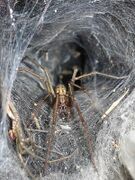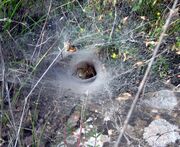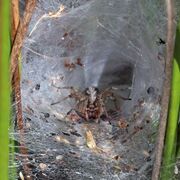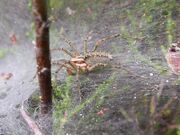Biology:Agelenidae
| Funnel weavers | |
|---|---|
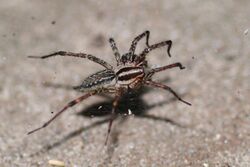
| |
| Grass spider (Agelenopsis sp.), female | |
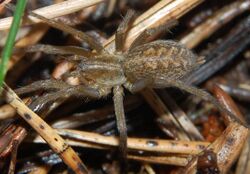
| |
| Hobo spider (E. agrestis) | |
| Scientific classification | |
| Domain: | Eukaryota |
| Kingdom: | Animalia |
| Phylum: | Arthropoda |
| Subphylum: | Chelicerata |
| Class: | Arachnida |
| Order: | Araneae |
| Infraorder: | Araneomorphae |
| Family: | Agelenidae C. L. Koch, 1837 |
| Diversity | |
| 92 genera, 1374 species | |
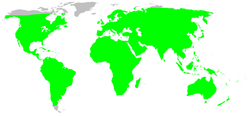
| |
The Agelenidae are a large family of spiders in the suborder Araneomorphae. Well-known examples include the common "grass spiders" of the genus Agelenopsis. Nearly all Agelenidae are harmless to humans, but the bite of the hobo spider (Eratigena agrestis) may be medically significant, and some evidence suggests it might cause necrotic lesions,[1] but the matter remains subject to debate.[2] The most widely accepted common name for members of the family is funnel weaver.[3]
Description
The body length of the smallest Agelenidae spiders are about 4 mm (0.16 in), excluding the legs, while the larger species grow to 20 mm (0.79 in) long. Some exceptionally large species, such as Eratigena atrica, may reach 5 to 10 cm (2.0 to 3.9 in) in total leg span.
Agelenids have eight eyes in two horizontal rows of four. Their cephalothoraces narrow somewhat towards the front where the eyes are. Their abdomens are more or less oval, usually patterned with two rows of lines and spots. Some species have longitudinal lines on the dorsal surface of the cephalothorax, whereas other species do not; for example, the hobo spider does not, which assists in informally distinguishing it from similar-looking species.[4]
Biology
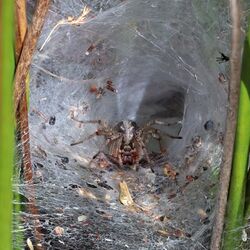
Most of the Agelenidae are very fast runners, especially on their webs. With speeds clocked at 1.73 ft/s (0.53 m/s), the giant house spider held the Guinness Book of World Records title for top spider speed until 1987. A recent literature review found peer-reviewed accounts of several agelenid species achieving speeds in this range, though some other taxa have achieved higher speeds.[5][6]
Agelenids build a flat sheet of nonsticky web with a funnel-shaped retreat to one side or occasionally in the middle, depending on the situation and species. Accordingly, "funnel weaver" is the most widely accepted common name for members of the family, but they should not be confused with the so-called "funnel-web tarantulas" or "funnel-web spiders" of mygalomorph families.[3]
The typical hunting mode for most sheet-building Agelenidae is similar to that of most other families of spiders that build sheet webs in the open, typically on grass or in scrubland as opposed to under bark, rocks, and the like. They await the arrival of prey such as grasshoppers that fall onto the horizontal web. Although the web is not sticky, it is full of entangling filaments that the spider continually lays down when passing over. The filaments catch in the least projections on a prey insect's body or limbs. The web also is springy, and whether perching on the sheet or awaiting prey in its retreat, the spider reacts immediately to vibrations, whether from a courting male, the threatening struggles of dangerous invaders, or the weaker struggles of potential meals. They attack promising prey by rushing out at high speed and dealing a paralysing venomous bite. The agatoxin in their venom has been studied extensively in Agelenopsis aperta.[7] Once the prey has been disabled, the spider generally drags it back into the retreat and begins to feed. This method of attack is consistent with the high speeds at which the Agelenidae run. Other sheet-web hunters such as some Pisauridae also are very fast runners.
Like any fast-running spider, the Agelenidae possess good vision, and are generally photosensitive (i.e. react to changes in the light), so they can successfully retreat upon perceiving a larger threat's shadow approaching. Some are also sensitive to wind blows, and can retreat before the prey even spots them. Males are less successful ambushers than females, so prefer to roam around and wander to new areas, rather than stay in one single web. In September, males of outdoors species (such as Agelenopsis and Agelena) can seek refuge within houses, usually nesting on or underneath outer windowsills, or also around the porch door. These spiders often are neither pest controllers nor pests themselves; they are very selective in their prey, and do not consume large quantities; also, they are immune to intimidation and come back to their webs even after being disturbed, unless they are completely destroyed.
Parasocial species
The type genus, Agelena, includes some parasocial spiders that live in complex communal webs in Africa. The best known of these is probably A. consociata. Social behaviour in these spiders comprises communal web-building, cooperative prey capture, and communal rearing of young. No trophallaxis occurs, though, nor does any true eusociality such as occurs in the social Hymenoptera (ants, bees, and wasps); for example, the spiders have no castes such as sterile workers or soldiers, and all females are reproductive.[8]
Medical significance
Only one species of agelenid has become prominent as a putative cause of a significant frequency of necrotic arachnidism; this is the hobo spider, Eratigena agrestis.[4] This perception arose when the species was accidentally introduced to the United States in the mid-20th century and propagated rapidly in several regions. It is a fairly large, rapidly moving spider, so accordingly alarms many people.[9] A few cases of bites have been reported in Southern California by the desert grass spider, Agelenopsis aperta, that resulted in symptoms, but determining whether these cases were confused with similar-looking spiders is difficult.[10]
Genera
(As of January 2023), the World Spider Catalog accepts these genera:[11]
- Acutipetala Dankittipakul & Zhang, 2008 — Thailand
- Aeolocoelotes Okumura, 2020 — Japan
- Agelena Walckenaer, 1805 — Africa, Asia, Italy
- Agelenella Lehtinen, 1967 — Yemen
- Agelenopsis Giebel, 1869 — North America, Ukraine, Asia
- Ageleradix Xu & Li, 2007 — China
- Agelescape Levy, 1996 — Asia
- Ahua Forster & Wilton, 1973 — New Zealand
- Allagelena Zhang, Zhu & Song, 2006 — Asia
- Alloclubionoides Paik, 1992 — Asia
- Asiascape Zamani & Marusik, 2020 — Iran
- Aterigena Bolzern, Hänggi & Burckhardt, 2010 — China, Italy, France
- Azerithonica Guseinov, Marusik & Koponen, 2005
- Bajacalilena Maya-Morales & Jiménez, 2017 — Mexico
- Barronopsis Chamberlin & Ivie, 1941 — Cuba, United States
- Benoitia Lehtinen, 1967 — Asia, Africa, Spain
- Bifidocoelotes Wang, 2002 — China
- Cabolena Maya-Morales & Jiménez, 2017 — Mexico
- Calilena Chamberlin & Ivie, 1941 — United States, Mexico
- Callidalena Maya-Morales & Jiménez, 2017 — Mexico, United States
- Coelotes Blackwall, 1841 — Asia, Europe, Mexico
- Coras Simon, 1898 — United States, Canada, Korea
- Curticoelotes Okumura, 2020 — Japan
- Dichodactylus Okumura, 2017 — Japan
- Draconarius Ovtchinnikov, 1999 — Asia
- Eratigena Bolzern, Burckhardt & Hänggi, 2013 — North America, Europe, Algeria, Asia
- Femoracoelotes Wang, 2002 — Taiwan
- Flexicoelotes Chen, Li & Zhao, 2015 — China
- Gorbiscape Zamani & Marusik, 2020 — Western Mediterranean, Tajikistan
- Griseidraconarius Okumura, 2020 — Japan
- Guilotes Zhao & S. Q. Li, 2018 — China
- Hadites Keyserling, 1862 — Croatia
- Hengconarius Zhao & S. Q. Li, 2018 — China
- Himalcoelotes Wang, 2002 — Nepal, Bhutan, China
- Histopona Thorell, 1869 — Europe
- Hoffmannilena Maya-Morales & Jiménez, 2016 — Mexico, Guatemala
- Hololena Chamberlin & Gertsch, 1929 — United States, Canada, Mexico
- Huangyuania Song & Li, 1990 — China
- Huka Forster & Wilton, 1973 — New Zealand
- Hypocoelotes Nishikawa, 2009 — Japan
- Inermocoelotes Ovtchinnikov, 1999 — Europe
- Iwogumoa Kishida, 1955 — Asia
- Jishiyu Lin & Li, 2023 — China
- Kidugua Lehtinen, 1967 — Congo
- Lagunella Maya-Morales & Jiménez, 2017
- Leptocoelotes Wang, 2002 — Taiwan
- Lineacoelotes Xu, Li & Wang, 2008 — China
- Longicoelotes Wang, 2002 — China, Japan
- Lycosoides Lucas, 1846 — Africa, Azerbaijan, Spain
- Mahura Forster & Wilton, 1973 — New Zealand
- Maimuna Lehtinen, 1967 — Asia, Greece
- Malthonica Simon, 1898 — Greece, Portugal, France
- Melpomene O. Pickard-Cambridge, 1898 — North America, Central America
- Mistaria Lehtinen, 1967 — Kenya, Yemen
- Neorepukia Forster & Wilton, 1973 — New Zealand
- Neotegenaria Roth, 1967 — Guyana
- Neowadotes Alayón, 1995 — Hispaniola
- Nesiocoelotes Okumura & Zhao, 2022 — Japan
- Notiocoelotes Wang, Xu & Li, 2008 — China
- Novalena Chamberlin & Ivie, 1942 — North America, Central America, Trinidad
- Nuconarius Zhao & S. Q. Li, 2018 — China
- Olorunia Lehtinen, 1967 — Congo
- Oramia Forster, 1964 — New Zealand, Australia
- Oramiella Forster & Wilton, 1973 — New Zealand
- Orumcekia Koçak & Kemal, 2008 — China, Vietnam
- Papiliocoelotes Zhao & Li, 2016 — China
- Paramyro Forster & Wilton, 1973 — New Zealand
- Persilena Zamani & Marusik, 2020 — Iran
- Persiscape Zamani & Marusik, 2020 — Western Asia, Greece
- Pireneitega Kishida, 1955 — Asia, Europe
- Platocoelotes Wang, 2002 — China, Japan
- Porotaka Forster & Wilton, 1973 — New Zealand
- Pseudotegenaria Caporiacco, 1934 — Libya
- Robusticoelotes Wang, 2002 — China
- Rothilena Maya-Morales & Jiménez, 2013 — Mexico
- Rualena Chamberlin & Ivie, 1942 — United States, Mexico
- Sinocoelotes Zhao & Li, 2016 — China, Thailand
- Sinodraconarius Zhao & S. Q. Li, 2018 — China
- Spiricoelotes Wang, 2002 — China, Japan
- Tamgrinia Lehtinen, 1967 — India, China
- Tararua Forster & Wilton, 1973 — New Zealand
- Tegecoelotes Ovtchinnikov, 1999 — Asia
- Tegenaria Latreille, 1804 — Europe, Asia, Africa, North America, Oceania, South America, Jamaica
- Textrix Sundevall, 1833 — Asia, Europe, Ethiopia
- Tikaderia Lehtinen, 1967 — Himalayas
- Tonsilla Wang & Yin, 1992 — China
- Tortolena Chamberlin & Ivie, 1941 — United States, Mexico, Costa Rica
- Troglocoelotes Zhao & S. Q. Li, 2019 — China
- Tuapoka Forster & Wilton, 1973 — New Zealand
- Urocoras Ovtchinnikov, 1999 — Europe, Turkey
- Vappolotes Zhao & S. Q. Li, 2019 — China
- Wadotes Chamberlin, 1925 — United States, Canada
A number of fossil species are known from Eocene aged Baltic amber, but their exact relationship with extant members of the clade is unclear.[12]
female E. atrica at the mouth of her retreat
A. labyrinthica, male (immature)
See also
References
- ↑ Goddard, Jerome (3 December 2012). Physician's Guide to Arthropods of Medical Importance (6th ed.). CRC Press. p. 380. ISBN 978-1-4398-5085-5. https://books.google.com/books?id=ZVPWy-3_YHsC&pg=PA380.
- ↑ Gaver-Wainwright, Melissa M.; Zack, Richard S.; Foradori, Matthew J.; Lavine, Laura Corley (2011). "Misdiagnosis of Spider Bites: Bacterial Associates, Mechanical Pathogen Transfer, and Hemolytic Potential of Venom from the Hobo Spider, Eratigena agrestis (Araneae: Agelenidae)". Journal of Medical Entomology 48 (2): 382–388. doi:10.1603/ME09224. PMID 21485377.
- ↑ 3.0 3.1 Breene (2003). Common Names of Arachnids (5th ed.). http://www.americanarachnology.org/acn5.pdf. Retrieved 2006-09-27.
- ↑ 4.0 4.1 Vetter, R. S., and A. L. Antonelli. 2002. How to identify (or misidentify) the hobo spider. Wash. St. Coop. Ext. Pest Leafl. Series No. 116
- ↑ Spagna, J. C.; Peattie, A. M. (2012). "Terrestrial locomotion in arachnids". Journal of Insect Physiology 58 (5): 599–606. doi:10.1016/j.jinsphys.2012.01.019. PMID 22326455.
- ↑ Gorb, S.N.; Barth, F.G. (1994). "Locomotor behavior during prey-capture of a fishing spider, Dolomedes plantarius (Araneae: Araneidae): galloping and stopping". The Journal of Arachnology 22: 89–93.
- ↑ Adams, Michael E. (April 2004). "Agatoxins: ion channel specific toxins from the american funnel web spider, Agelenopsis aperta". Toxicon 43 (5): 509–525. doi:10.1016/j.toxicon.2004.02.004. ISSN 0041-0101. PMID 15066410. http://dx.doi.org/10.1016/j.toxicon.2004.02.004.
- ↑ Rainer Foelix (3 December 2010). Biology of Spiders. Oxford University Press, USA. pp. 320–. ISBN 978-0-19-981324-7. https://books.google.com/books?id=fLKZtBJBjqMC&pg=PA320.
- ↑ Vetter, Richard S.; Isbister, Geoffrey K. (December 2004). "Do Hobo Spider Bites Cause Dermonecrotic Injuries?". Annals of Emergency Medicine 44 (6): 605–7. doi:10.1016/j.annemergmed.2004.03.016. PMID 15573036.
- ↑ Vetter, Richard S (December 1998). "Envenomation by a spider, Agelenopsis aperta (Family: Agelenidae) Previously Considered Harmless". Annals of Emergency Medicine 32 (6): 739–741. doi:10.1016/s0196-0644(98)70076-9. ISSN 0196-0644. PMID 9832673. http://dx.doi.org/10.1016/s0196-0644(98)70076-9.
- ↑ "Family: Agelenidae C. L. Koch, 1837". Natural History Museum Bern. http://www.wsc.nmbe.ch/family/2.
- ↑ Magalhaes, Ivan L. F.; Azevedo, Guilherme H. F.; Michalik, Peter; Ramírez, Martín J. (February 2020). "The fossil record of spiders revisited: implications for calibrating trees and evidence for a major faunal turnover since the Mesozoic" (in en). Biological Reviews 95 (1): 184–217. doi:10.1111/brv.12559. ISSN 1464-7931. PMID 31713947. https://onlinelibrary.wiley.com/doi/10.1111/brv.12559.
Further reading
- Kaston, Benjamin Julian (1953). How to Know the Spiders. Pictured key nature series (1st ed.). Dubuque, IA: W.C. Brown Co.. ISBN 0-697-04898-5. OCLC 681432632. https://archive.org/details/howtoknowspiders0000kast.
- Foelix, Rainer F. (2011). Biology of Spiders (3rd ed.). Oxford: Oxford University Press. ISBN 978-0-19-973482-5. OCLC 963876029.
External links
Wikidata ☰ Q5850 entry
 |
